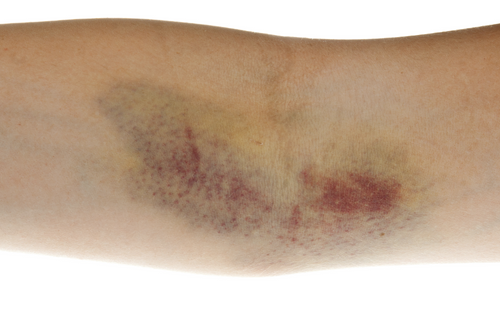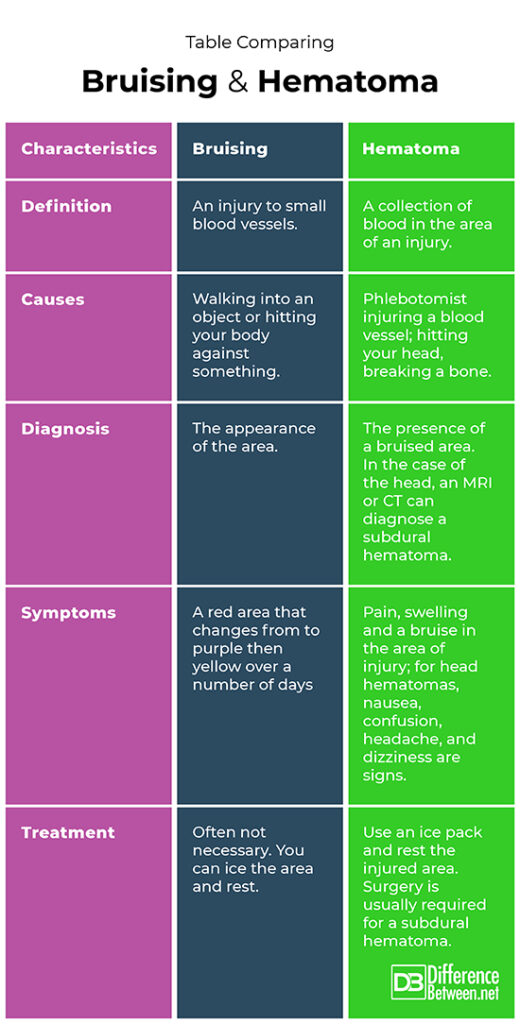Difference Between Bruising and Hematoma
Bruising is when small blood vessels are broken. A hematoma is when blood actually accumulates in an area where there is an injury.

What is Bruising?
Definition:
Bruising is the result of blood capillaries being damaged and breaking.
Causes and risk factors:
A bruise happens when you have injured yourself in some way. Often bumping into objects or a fall can result in bruising. Bruising is also common after you have had an IV placed in your arm. Some people are at increased risk of a bruise. For instance, people who have the condition purpura simplex bruise very easily. Drugs that prevent clotting and aspirin, can increase the chance of bruises.
Diagnosis and symptoms:
Diagnosis is made by physical appearance. A bruise is red at first when it first appears, later changing in color to a purple patch then after a number of days, the bruise will appear yellow in color. Bruises can be a symptom of serious underlying conditions, so if you bruise often and without reason, it is best to check with your doctor.
Treatment:
A bruise usually resolves on its own. A person can place an ice pack on the area of injury but in many cases, it is not needed.

What is Hematoma?
Definition:
A hematoma is an accumulation of blood and it often does occur after a bruising incident. It is a more severe injury than a simple bruise.
Causes and risk factors:
Hematomas can be caused by many things including a broken bone. A head injury can also cause a hematoma. It can be a complication of a blood test if a phlebotomist accidentally puts a needle through the wall of a blood vessel. Leukemia and blood clotting problems may also result in hematomas. Alcoholism and taking anticoagulant medicine are risk factors for hematomas.
Diagnosis and symptoms:
Diagnosis is by noting the presence of a bruised area. The region will also be painful. In the case of a subdural hematoma, neurological symptoms such as confusion, headache, nausea, and dizziness may be present. The person will also often have a history of hitting their head.
Treatment:
Treatment depends on the type of hematoma. Simple hematomas under the skin can be treated by using an ice pack for about 20 mins at a time; this will help with any pain and swelling. A hematoma due to a blood test or IV normally resolves by itself. A hematoma in the brain or between the brain and dural membrane needs to be surgically drained to prevent injury to the cerebrum.
Difference between Bruising and Hematoma?
Definition
Bruising is when there is an injury to small blood vessels. A hematoma is when there is a collection of blood in the area of an injury.
Causes
Bumping into something or else a disease like leukemia can cause bruising. Phlebotomy, traumatic injury, broken bones, and bleeding on the brain can result in a hematoma.
Diagnosis
A bruise is diagnosed based on its appearance. A hematoma is diagnosed based on the appearance of a bruise and by CT or MRI (for brain hematoma).
Symptoms
A bruise appears as a reddened area that changes to purple and then yellow over a number of days. A hematoma appears like a bruise but also has signs such as swelling and pain. A brain hematoma has additional signs like dizziness and nausea.
Treatment
Treating a bruise is not usually needed but you can use an ice pack. Treating a hematoma involves using an ice pack; in the case of a subdural hematoma, surgery is needed.
Table comparing Bruising and Hematoma

Summary of Bruising Vs. Hematoma
- A bruise and hematoma often look similar but a hematoma is more serious.
- Most bruising and hematomas are not dangerous.
- A hematoma on the brain is dangerous and needs surgical repair.
FAQ
What does a hematoma look like?
A hematoma often looks like a bruise and will be a purple region. It is often painful in the area where the hematoma is, and swelling often is present.
Can a hematoma be a bruise?
A hematoma is actually a type of bruise.
How can you tell if you have a hematoma?
The symptoms of a hematoma depend on where it is and can include pain and swelling. If it occurs in the brain, then neurological signs will appear including confusion and dizziness.
When should I be concerned about a hematoma?
A hematoma may not an issue but if pain continues or if you have bumped your head and showing neurological symptoms, a doctor should be seen right away.
How long does it take for a hematoma to go away?
It depends where a hematoma is, but most often it will disappear in a couple of days. However, a hematoma on the surface of or in the brain is dangerous. You may need surgery for cranial hematomas, including subdural hematomas.
What are 3 causes of a hematoma?
A traumatic injury like a broken bone, injury to a vein during phlebotomy, and a head injury.
How do you know when a bruise is serious?
A bruise that does not heal is very painful and accompanied by other symptoms such as bleeding gums, which should be investigated further by consulting a doctor.
What is considered a large hematoma?
A large hematoma is when the size is more than 1 cm in diameter.
Can you get a blood clot from a hematoma?
A hematoma does not result in blood clots. However, a blood clot in the leg or a deep vein thrombosis can cause a hematoma.
- Difference Between Rumination and Regurgitation - June 13, 2024
- Difference Between Pyelectasis and Hydronephrosis - June 4, 2024
- Difference Between Cellulitis and Erysipelas - June 1, 2024
Search DifferenceBetween.net :
References :
[0]Ducruet, Andrew F., et al. "The surgical management of chronic subdural hematoma." Neurosurgical review 35.2 (2012): 155-169.
[1]Skow, Glenn. "Easy Bruising, Low Platelets, Recent Coldlike Illness."
[2]Stephenson, Terence, and Yvona Bialas. "Estimation of the age of bruising." Archives of Disease in Childhood 74.1 (1996): 53-55.
